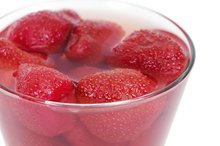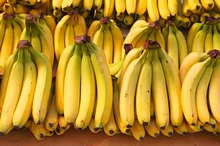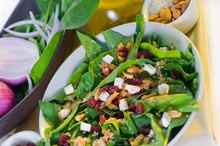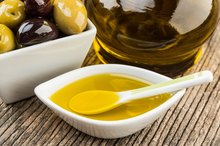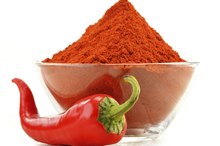How to Avoid a Bitter Banana Taste in a Smoothie
Bananas, filled with fiber and potassium, are commonly used in smoothies due to their thick texture and strong, sweet flavor. Drinking smoothies made with wholesome ingredients like bananas helps satisfy your appetite and nutritional needs, while maintaining a healthy diet. However, a bitter drink is not satisfying; start with the right ingredients for a delicious and filling smoothie.
Check the bananas you are using to be sure they are ripe and ready to eat; unripe bananas contain less sugar and can have a bitter taste 3. Overripe bananas are ideal for smoothies, since they are at their sweetest and have a more intense banana flavor.
How to Marinate Strawberries
Learn More
Ripen your bananas, if necessary, by placing them in a paper bag 2. Accelerate the process by putting a ripe banana or apple into the bag with unripe bananas; ripe fruit releases ethylene gas, which helps ripen the bananas.
Add sweet fruits to your smoothie, like raspberries and strawberries 2. Both blend well with bananas and can counteract any bitter taste.
Is Eating a Lot of Bananas Healthy?
Learn More
Pour ¼ to ½ cup of apple or orange juice into your smoothie; naturally sweet juice helps transform any bitterness.
Place 1 to 2 tbsp. of peanut butter into the blender when mixing your smoothie; peanut butter has a natural sweetness that pairs well with bananas 4.
Tips
When preparing bananas for your smoothie, make sure to remove any fibrous membrane left from the peeling, which often has a bitter taste, especially in less ripe bananas.
Use plain yogurt in your smoothie and sweeten it naturally with fruits and juices. Avoid adding sugars, honey or flavored yogurts with sugar, which adds unwanted calories.
Related Articles
References
- “The Essential Baking Cookbook”; Murdoch Books; 2005
- Readers Digest Version: 2 Easy Ways to Ripen Fruit
- "Women's Health; The Abs Diet: Eat More, Weigh Less; Fall/Winter 2004
- Highlight Health; Health Benefits of Bananas; Walter Jessen; January 2007
- Bananas, raw. FoodData Central. U.S. Department of Agriculture. Published April 1, 2019.
- Glycemic index for 60+ foods. Harvard Health Publishing, Harvard Medical School. Updated 2020.
- Nutritional Goals for Age-Sex Groups Based on Dietary Reference Intakes and Dietary Guidelines Recommendations. USDA. 2015
- Falcomer AL, Riquette RFR, De lima BR, Ginani VC, Zandonadi RP. Health benefits of green banana consumption: A systematic review. Nutrients. 2019;11(6). doi:10.3390/nu11061222
- Klemm S. Prebiotics and probiotics: Creating a healthier you. Academy of Nutrition and Dietetics. Updated 2020.
- Howarth NC, Saltzman E, Roberts SB. Dietary fiber and weight regulation. Nutr Rev. 2001;59(5):129-39. doi:10.1111/j.1753-4887.2001.tb07001.x
- Pereira A, Maraschin M. Banana (Musa spp) from peel to pulp: ethnopharmacology, source of bioactive compounds and its relevance for human health. J Ethnopharmacol. 2015;160:149-63. doi: 10.1016/j.jep.2014.11.008
- Vitamin C: Fact Sheets for Health Professionals. National Institutes of Health, Office of Dietary Supplements. Updated 2020.
- Hassan AK, Venkatesh YP. An overview of fruit allergy and the causative allergens. Eur Ann Allergy Clin Immunol. 2015;47(6):180-7.
- Manohar M, Verma AK, Upparahalli Venkateshaiah S, Goyal H, Mishra A. Food-induced acute pancreatitis. Dig Dis Sci. 2017;62(12):3287-3297. doi:10.1007/s10620-017-4817-2
Writer Bio
Beth Rifkin has been writing health- and fitness-related articles since 2005. Her bylines include "Tennis Life," "Ms. Fitness," "Triathlon Magazine," "Inside Tennis" and others. She holds a Bachelor of Business Administration from Temple University.
